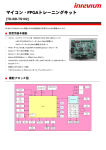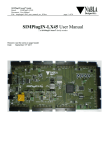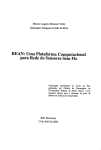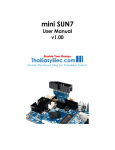Download PXS61 User`s Manual PoliTekno
Transcript
PXS61 Series User’s Manual A compact (68mm x 63mm) FPGA board featuring Xilinx Spartan-6 LX FPGA and on board LPDDR SDRAM Copyright © 2012 PoliTekno Ltd. PoliTekno Ltd. Cyberpark Cyberplaza B Blok 2. Kat No:B225 Bilkent 06800 Ankara / TURKEY +90 312 265 03 30 www.politekno.com [email protected] All rights reserved. Unauthorized duplication in whole or part of this document is prohibited without the express written permission of PoliTekno Ltd. PoliTekno and PoliTekno Logo are trademarks of PoliTekno Ltd. All other trademarks referenced herein are the property of their respective owners and no trademark rights to the same are claimed. Disclaimer • PoliTekno assumes no liability whatsoever for any direct, indirect, special, incidental, or consequential damages arising from the use of this product. • While every effort has been made to ensure that the information provided on this manual is accurate, PoliTekno assumes no liability or responsibility for any errors or omissions in the content of this manual. • PoliTekno reserves the right to make changes and/or improvements to the products contained in this manual without any notice. Revision History: Date 2012-04-24 Description Initial release Table of Contents 1 Introduction ................................................................................................................................... 4 1.1 Description ...................................................................................................................................................... 4 1.2 Features ........................................................................................................................................................... 5 1.3 Module Configurations .................................................................................................................................... 5 1.4 Overview.......................................................................................................................................................... 6 2 Functional Description.................................................................................................................... 7 2.1 Block Diagram .................................................................................................................................................. 7 2.2 Power Supply ................................................................................................................................................... 8 2.3 Spartan-6 FPGA................................................................................................................................................ 8 2.3.1 Power-On Configuration............................................................................................................................9 2.3.2 Power-On I/O State ................................................................................................................................ 10 2.4 LPDDR SDRAM ............................................................................................................................................... 11 2.5 SPI Flash ......................................................................................................................................................... 11 2.6 Clock Source .................................................................................................................................................. 12 2.7 LEDs ............................................................................................................................................................... 12 2.8 JTAG Connector ............................................................................................................................................. 13 2.9 External I/O Interface .................................................................................................................................... 14 3 Module Configuration .................................................................................................................. 17 3.1 JTAG Interface ............................................................................................................................................... 17 3.1.1 Generating an FPGA Configuration File .................................................................................................. 18 3.1.2 Configuring FPGA via JTAG interface ...................................................................................................... 18 3.2 Serial Configuration Interface ....................................................................................................................... 20 3.2.1 Generating a Flash Programming File .................................................................................................... 20 3.2.2 Indirect Programming of SPI Flash using Impact .................................................................................... 25 4 Technical Specifications ................................................................................................................ 32 4.1 Absolute Maximum Ratings........................................................................................................................... 32 4.2 Recommended Operating Conditions ........................................................................................................... 33 4.3 Mechanical Data ............................................................................................................................................ 33 4.3.1 Module Dimensions................................................................................................................................ 33 4.3.2 Top/Bottom Views.................................................................................................................................. 34 5 Support ........................................................................................................................................ 35 PXS61 User’s Manual PoliTekno 1 Introduction 1.1 Description The PXS61 is a compact (68mm x 63mm, 2.67" x 2.48") FPGA board featuring the Xilinx Spartan-6 FPGA. Designed as a full-featured integration system, the PXS61 module supports up to 128-MByte LPDDR SDRAM and 128 Mbit SPI Flash. With over 60 I/O pins the PXS61 is designed to work with small to medium-sized FPGA designs with a wide variety of external interface requirements. The PXS61 has two standard 40-pin (2.54mm/100mil spaced) connectors on the bottom side. A mechanical drawing of the PXS61 is shown at the end of this manual. Module connectors provide easy access to many FPGA pins and dedicated module power supply pins. A simple base board which generates necessary voltages for the module can be provided as an optional accessory for the PXS61 board. www.politekno.com 4 PXS61 User’s Manual PoliTekno 1.2 Features Xilinx Spartan-6 LX9/LX16/LX25 FPGAs up to 24,000 logic cells 6 pins header for FPGA configuration via JTAG 4/8/32/128 Mbit SPI Flash memory for FPGA configuration data (can be used also for storing user data) FPGA programming / debugging via JTAG connector 62 General Purpose I/O's (GPIO): • Fit the standard 2.54mm / 0.1" headers allowing a wide range of additional functionality to be added to the base board • Available with and without soldered pitch pin headers Done LED for identification of successful FPGA configuration 2 user LEDs for fast debugging 32 or 128 MByte DDR SDRAM: • Up to 166 MHz clock frequency • 16 bit data bus width • MicroBlaze memory interface controller codes available Temperature range: 0 to +70°C (commercial) or -40 to +85°C (industrial) versions available 1.3 Module Configurations The following table shows part numbers and available module configurations. Custom configurations are possible; please contact us for further information. Ordering Code FPGA LPDDR SDRAM SPI Flash Temp. Range PXS61-LX9-M0-F4 XC6SLX9-2FTG256C - 4Mbit 0 to 70°C PXS61-LX16-M0-F4 XC6SLX16-2FT256C - 4Mbit 0 to 70°C PXS61-LX25-M0-F8 XC6SLX25-2FT256I - 8 Mbit -40 to 85°C PXS61-LX16-M32-F32 XC6SLX16-2FT256C 32 MByte 32 Mbit 0 to 70°C PXS61-LX25-M128-F128 XC6SLX25-2FT256I 128 MByte 128 Mbit -40 to 85°C Each PXS61 series FPGA module is pin-to-pin compatible with each other. So increasing the FPGA capacity or memory size is as easy as replacing the module with a higher capacity version without a change needed in the base board design. www.politekno.com 5 PXS61 User’s Manual PoliTekno 1.4 Overview Following figure shows board layout and components. I/O Connector (P2) User LEDs JTAG Connector (P3) Spartan-6 FPGA 50 MHz Clock Configuration Done LED LPDDR SDRAM SPI Flash I/O Connector (P1) www.politekno.com 6 PXS61 User’s Manual PoliTekno 2 Functional Description 2.1 Block Diagram External I/O Interface (P1) 32 GPIOs LPDDR SDRAM (32/128 MByte) JTAG Header (P3) up to 166 MHz Xilinx Spartan6 FPGA (LX9/LX16/LX25) SPI Flash Memory (4/8/32/128 Mbit) Clock (50 MHz) Done LED 2 User LEDs 30 GPIOs External I/O Interface (P2) www.politekno.com 7 PXS61 User’s Manual PoliTekno 2.2 Power Supply The PXS61 module takes its supply voltages from the two external I/O interface connectors P1 and P2. The internally required 1.2V, 1.8V, and 3.3V voltages and signal ground must be supplied from the following connector pins: Power Signals 1.2V 1.8V 3.3V GND Connector Pins P1-19 P2-15 P1-38 P2-29 P1-18 P1-14 P2-16 P1-39 P2-28 P1-16 P2-14 P1-17 P2-18 P1-20 P2-27 P1-37 P2-30 P1-40 The external power supply should be sufficient and stabilized. For more details, please refer to Section 4 for recommended operating conditions. The current required on these supply pins depends on user application i.e the number of I/O pins utilized, operating frequency and the number of simultaneously switching outputs. So please use a tool like Xilinx XPower Estimator to estimate the expected power consumption of your design. For details see Xilinx Power Tools Tutorial – UG733 from Xilinx. 2.3 Spartan-6 FPGA A Spartan-6 LX FPGA (logic optimized) lies at the heart of every PXS61 series module. Built on a 45 nm process technology, Spartan-6 family of FPGAs delivers expanded densities, with half the power consumption of previous Spartan families, and faster, more comprehensive connectivity. The table below shows summary of Spartan-6 LX FPGA features. www.politekno.com 8 PXS61 User’s Manual PoliTekno Depending on configuration, PXS61 series modules utilize XC6SLX9 or XC6SLX16 or XC6SLX25 FPGAs from the Spartan-6 family. See Section 1.3 for module configurations. Having the same 256 pin FT(G)256 package, module’s FPGAs are 100% pinout compatible. See Spartan-6 FPGA Packaging and Pinouts – UG 385 for details of FT(G)256 package pinout. On each PXS61 module, following power rails are connected to VCCO pins of FPGA banks: FPGA Banks Bank 0 Bank 1 Bank 2 Bank 3 Supply Voltage 3.3V 3.3V 3.3V 1.8V FPGA Bank 3 is used for interfacing on board LPDDR SDRAM so it is supplied with 1.8V. All other banks of the FPGA are powered from 3.3V power rail. 2.3.1 Power-On Configuration After power-up, SPI Flash memories must not be accessed for a certain period of time (called tpu or tpor). During this period all operations are disabled, and the flash does not respond to any instruction. For some SPI Flash memories, this power-up time can be up-to 10-15 milliseconds. This may cause some problems because at power-on FPGA sends a read command to the SPI Flash to acquire the configuration data bitstream. In PXS61 modules, a voltage supervisor IC was used to solve this issue. The circuitry to guarantee power-on compatibility between FPGA and SPI Flash is shown below. 3.3V VCCO_2 VCC SPI Flash FPGA PROGRAM_B RESET# Voltage Supervisor The open drain RESET# output of the supervisor chip is connected to the PROGRAM_B pin of the module’s FPGA. PROGRAM_B pin controls the configuration cycle of Spartan-6 FPGAs and must be High to allow configuration to start. www.politekno.com 9 PXS61 User’s Manual PoliTekno The supervisor IC monitors the 3.3V power rail and keeps its RESET# output Low as long as the supply rail remains below the threshold value (3.15V). After this threshold value is reached, an internal timer delays (120 milliseconds) the return of the RESET# output to the High state to ensure proper system start-up. So the RESET# signal (and FPGA’s PROGRAM_B pin) is held Low until power supply voltage reaches 3.15V + 120 ms reset delay time. After this point, RESET# is released by the supervisor and PROGRAM_B goes to High via a pull-up resistor. The power-on timing of the FPGA’s PROGRAM_B pin is illustrated in the figure below. So, this way, the configuration cycle of the FPGA is delayed during every power-on and guaranteed power-on compatibility between FPGA and SPI Flash is achieved by holding PROGRAM_B pin Low until SPI Flash has powered up reliably and is ready to accept commands. 2.3.2 Power-On I/O State In all versions of the PXS61 modules, the HSWAPEN pin (C4 on the FPGA) was directly connected to GND via resistor R9. This enables pull-up resistors on all FPGA I/Os from poweron throughout configuration (See Spartan-6 FPGA Configuration User Guide – UG380 from Xilinx). However a resistor (R21) was also added to set HSWAPEN pin to High if needed. Therefore, there are two possible configurations for the HSWAPEN pin: HSWAPEN Low (default Configuration via resistor R9) HSWAPEN is grounded. This enables user I/O pull-up resistors from power-on throughout configuration. HSWAPEN High (alternative configuration via R21) Remove R9 and solder R21 (a 0-Ω resistor). This way HSWAPEN is pulled high. This disables the FPGA user I/O pull-up resistors allowing FPGA I/Os to float from power-on throughout configuration. www.politekno.com 10 PXS61 User’s Manual PoliTekno 2.4 LPDDR SDRAM The PXS61 series modules are equipped with 32/128 MByte mobile low-power DDR SDRAM memory. The memory device has an operating voltage of 1.8V and the interface is mobile DDR. Maximum clock rate of the LPDDR SDRAM is 166 MHz and the interface signals are connected to I/O Bank 3 of the FPGA. The following figure shows a high-level block diagram of the LPDDR Mobile SDRAM interface on the PXS61 module. Module’s SDRAM is attached exclusively to the FPGA and does not share any pins with the external I/O connector. The table below lists the LPDDR SDRAM memories available in PXS61 series modules: Memory Type Size Configuration Manufacturer MT46H16M16LFBF-6 IT 32 MByte (256 Mbit) 16M x 16bit (4 Meg x 16 x 4 Banks) Micron MT46H64M16LFBF-6 IT 128 MByte (1 Gbit) 64M x 16bit (16 Meg x 16 x 4 Banks) Micron 2.5 SPI Flash Depending on configuration, PXS61 series modules contains 4/8/32/128 Mbit SPI Flash memory. The table below shows the SPI Flash memories contained in PXS61 series FPGA modules. Module SPI Flash Size Manufacturer Manufacturer Part No. PXS61-LX9-M0-F4 4Mbit M25P40 Numonyx PXS61-LX16-M0-F4 4Mbit M25P40 Numonyx PXS61-LX25-M0-F8 8 Mbit M25P80 Numonyx PXS61-LX16-M32-F32 32 Mbit S25FL032P Spansion PXS61-LX25-M128-F128 128 Mbit N25Q128 Numonyx www.politekno.com 11 PXS61 User’s Manual PoliTekno The SPI Flash can be used to store the FPGA configuration bitstream and connected to the FPGA’s configuration port. The size of the bitstream is dependent of the equipped FPGA type (for more information about Spartan-6 FPGA bitstream lengths please refer to the Spartan-6 FPGA Configuration User Guide – UG380). After configuration, the remaining SPI Flash sectors are available for user data storage. The following figure shows SPI Flash interface connections and associated signal names on the PXS61 module. Utilize these FPGA pins to use the SPI Flash as a non-volatile memory element after configuration. 3.3V 3.3V CCLK CSO_B Spartan-6 FPGA MOSI WP# SPI Flash HOLD# DIN Signal Name FPGA Pin FPGA Pin Type Flash Pin Name* FPGA_CCLK R11 IO_L1P_CCLK_2 SCK / C FPGA_CSO_B T3 IO_L65N_CSO_B_2 CS# / S# FPGA_MOSI T10 IO_L3N_MOSI_CSI_B_MISO0_2 SI / DQ0 / D FPGA_DIN P10 IO_L3P_D0_DIN_MISO_MISO1_2 SO / DQ1 / Q * Flash pin names differ depending on manufacturer Please refer to Section 3 for more details about FPGA configuration and programming the SPI Flash memory. 2.6 Clock Source On PXS61 modules, a crystal oscillator with frequency of 50 MHz is connected to the FPGA. This clock source can be used to generate new clocks within the FPGA using DCM's or PLL's. Frequency FPGA Pin FPGA Pin Type 50 MHz J16 IO_L43N_GCLK4_MQDQ5_1 Additional clocks can be connected to the GCLK pins of the FPGA through P1 and P2 I/O connector interface. 2.7 LEDs There are three LEDs populated on PXS61 modules. Two user LEDs and a configuration done LED. www.politekno.com 12 PXS61 User’s Manual PoliTekno Configuration LED: DONE DONE LED Indicates the configuration state of FPGA. LED Reference Color DONE D4 Green FPGA Pin Description P13 Configuration Done LED on – FPGA configured off – FPGA not configured User LEDs: LED1, LED2 Two user LEDs (LED1 & LED2) can be used to indicate status of the internal logic in FPGA or for debugging and similar purposes. These LEDs are lit by driving the associated FPGA I/O pin to logic high and are off when the pin is either low or not driven. LED Reference Color FPGA Pin Description LED1 D2 Yellow A4 User LED - Active high LED2 D3 Yellow D5 User LED - Active high 2.8 JTAG Connector P3 is the 2.54 mm/0.1", 6-pin JTAG connector on board and is used to configure the Spartan-6 FPGA and program the configuration device (SPI Flash). The PXS61 module has one device in the JTAG chain, the Spartan-6 FPGA. The JTAG connector pins are connected as shown below. Pin Signal FPGA Direction No. Name Pin Description 1 TMS A15 IN JTAG TMS 2 TDI C12 IN JTAG TDI 3 TDO E14 OUT JTAG TDO 4 TCK C14 IN JTAG TCK 5 GND - POWER Signal ground 6 VCC - POWER 3.3V Please pay attention not to attach cables in reverse You can use Digilent’s JTAG HS1 Programming Cable or a similar programmer to connect to the module’s JTAG interface. JTAG HS1 is compatible with all Xilinx tools, including iMPACT, Chipscope, and EDK. http://www.digilentinc.com/Products/Detail.cfm?NavPath=2,395,922&Prod=JTAG-HS1 www.politekno.com 13 PXS61 User’s Manual PoliTekno Module’s JTAG header pin order perfectly fits Digilent’s JTAG HS1 Programming Cable but be careful not to make a reverse connection. For details of JTAG configuration see Module Configuration section - Section 3. 2.9 External I/O Interface Two 40 pin (2x20) connectors, P1 and P2, are available on the bottom-side of the PXS61 series FPGA modules. These expansion connectors provide user access to 62 FPGA I/O pins as well as the pins to supply the board. With 2.54mm/0.1" pin spacing, these standard I/O connectors integrates easily with user’s custom base board design. See Section 4.3.1 for details of the layout of the module connectors. All external I/O interface signals are routed from FPGA Banks 0, 1 and 2 which are powered from 3.3V power rail. So, all of the FPGA I/O at these expansion connectors (P1 & P2) are 3.3V logic. The pin-out of the I/O connectors P1 & P2 are shown in the following tables: www.politekno.com 14 PXS61 User’s Manual PoliTekno Pin List (P1) Pin No. Pin No. FPGA Pin T4 (IO_L63N_2) R5 (IO_L48P_D7_2) T5 (IO_L48N_RDWR_B_VREF_2) T6 (IO_L47N_2) FPGA Pin P4 (IO_L63P_2) N5 (IO_L49P_D3_2) P5 (IO_L49N_D4_2) P6 (IO_L47P_2) 1 2 3 4 5 6 7 8 R7 (IO_L32P_GCLK29_2) 9 10 N6 (IO_L64N_D9_2) T7 (IO_L32N_GCLK28_2) 11 12 P7 (IO_L31P_GCLK31_D14_2) 13 14 3V3 15 16 GND GND 17 18 1V8 1V2 19 20 GND P9 (IO_L14N_D12_2) 21 22 T8 (IO_L30N_GCLK0_USERCCLK_2) T9 (IO_L23N_2) 23 24 R9 (IO_L23P_2) 25 26 27 28 29 30 31 32 R16 (IO_L49N_M1DQ11_1) 33 34 P15 (IO_L48P_HDC_M1DQ8_1) P16 (IO_L48N_M1DQ9_1) 35 36 N16 (IO_L45N_A0_M1LDQSN_1) GND 37 38 1V2 3V3 39 40 GND P8 (IO_L30P_GCLK1_D13_2) N8 (IO_L29N_GCLK2_2) T12 (IO_L52N_M1_DQ15_1) T13 (IO_L51N_M1DQ13_1) M9 (IO_L29P_GCLK3_2) T15 (IO_L50N_M1UDQSN_1) www.politekno.com R12 (IO_L52P_M1DQ14_1) T14 (IO_L51P_M1DQ12_1) R14 (IO_L50P_M1UDQS_1) R15 (IO_L49P_M1DQ10_1) 15 PXS61 User’s Manual PoliTekno Pin List (P2) Pin No. Pin No. FPGA Pin B5 (IO_L2P_0) A5 (IO_L2N_0) B6 (IO_L4P_0) A6 (IO_L4N_0) FPGA Pin C5 (IO_L3N_0) D6 IO_L7P_0() C6 (IO_L7N_0) C7 (IO_L6P_0) 1 2 3 4 5 6 7 8 A7 (IO_L6N_0) 9 10 D8 (IO_L38P_0) B8 (IO_L33P_0) 11 12 C8 (IO_L38N_VREF_0) A8 (IO_L33N_0) 13 14 GND 1V2 15 16 3V3 17 18 GND 19 20 C9 (IO_L34P_GCLK19_0) A10 (IO_L35N_GCLK16_0) 21 22 B10 (IO_L35P_GCLK17_0) A11 (IO_L39N_0) 23 24 A12 (IO_L62N_VREF_0) C11 (IO_L39P_0) 25 26 B12 (IO_L62P_0) GND 27 28 3V3 1V2 29 30 GND A14 (IO_L65N_SCP2_0) 31 32 A13 (IO_L63N_SCP6_0) B14 (IO_L65P_SCP3_0) 33 34 C10 (IO_L37N_GCLK12_0) B16 (IO_L29N_A22_M1A14_1) 35 36 B15 (IO_L29P_A23_M1A13_1) 37 38 39 40 A9 (IO_L34N_GCLK18_0) D9 (IO_L40N_0) C16 (IO_L33N_A14_M1A4_1) E16 (IO_L34N_A12_M1BA2_1) www.politekno.com C15 (IO_L33P_A15_M1A10_1) D16 (IO_L31N_A18_M1A12_1) 16 PXS61 User’s Manual PoliTekno 3 Module Configuration 3.1 JTAG Interface The FPGA devices on PXS61 series modules can be configured using the JTAG interface through header P3. Configuring FPGA directly from JTAG interface is volatile i.e. FPGA loses its configuration after reset or power cycle. Regardless of the configuration mode settings, the JTAG interface is available as a configuration interface any time the device is powered. JTAG interface can also be used for debugging Microblaze projects and viewing internal signals through ChipScope. www.politekno.com 17 PXS61 User’s Manual PoliTekno 3.1.1 Generating an FPGA Configuration File In order to configure module’s FPGA via JTAG directly, you should first generate the bit stream file (.bit file) by running Generate Programming File from Xilinx ISE. This is the final step in a typical FPGA synthesis flow. 3.1.2 Configuring FPGA via JTAG interface After generating an FPGA configuration file from ISE open Impact for configuration. While connected to the module through a programming cable, select Boundary-Scan from the Impact Flows menu. Right click in the Boundary Scan window and select Initialize Chain. www.politekno.com 18 PXS61 User’s Manual PoliTekno At this step you should see your device in the Boundary Scan window. Select Yes in the pop-up Auto Assign Configuration Files Query Dialog window and assign your bit-stream file. Select No when asked to attach an SPI or BPI PROM device. Right-click the FPGA icon in the Boundary Scan window and select Program. If configuration is completed successfully, the configuration done LED should light up on the PXS61 board. www.politekno.com 19 PXS61 User’s Manual PoliTekno 3.2 Serial Configuration Interface The SPI Flash can be used to store the FPGA configuration bitstream. This way, FPGA can read and configure itself at every power-up from the SPI Flash. Spartan-6 devices use two pins M1 and M0, which define the configuration modes. See the table below for different configuration modes of Spartan-6 devices. M[1:0] is configured as Master Serial mode (M[1:0] = 01) in PXS61 series modules. In master serial configuration mode, FPGA reads the bitstream from the SPI Flash (by loading one configuration bit per configuration clock cycle) during every power-up. For more information about the master serial configuration please refer to the Spartan-6 FPGA Configuration User Guide – UG380. 3.2.1 Generating a Flash Programming File In order to program the configuration flash you should first generate a flash programming file (.mcs file). Follow the steps below for generating flash programming file for your project. 1. Generate FPGA bitstream file (.bit file) from your FPGA project in ISE. 2. Open Impact. Select Yes from the pop-up menu below. www.politekno.com 20 PXS61 User’s Manual PoliTekno 3. Select Prepare a PROM File from the menu below. 4. From the PROM File formatter menu • Select Configure Single FPGA submenu under SPI Flash storage device type and click the green arrow. www.politekno.com 21 PXS61 User’s Manual PoliTekno • Select storage device capacity from the next column and click the Add Storage Device button. Select storage device capacity according to module configuration table in Section 1.3 (4M for PXS61-LX9-M0-F4, 8M for PXS61-LX25-M0-F8 etc.) then click the green arrow again. • Fill the output file name and output file location fields as your wish. Leave the Flash/PROM File Property fields as it is. www.politekno.com 22 PXS61 User’s Manual PoliTekno 5. Press OK after filling all these fields. The impact main menu will look like below. Select OK from the Add Device pop-up menu below. 6. A browse menu will appear. Go to the location of .bit file that you generated from ISE. Select the .bit file and click Open. www.politekno.com 23 PXS61 User’s Manual PoliTekno 7. Select No when asked to add another device file. 8. You are now completed the PROM file preparation steps. Select OK from the menu below. 9. Now select Generate File from Operations menu. www.politekno.com 24 PXS61 User’s Manual PoliTekno 10. A Flash programming file with the name given in Step 4 is generated under the file location specified again in Step 4. 3.2.2 Indirect Programming of SPI Flash using Impact After generating a flash programming file (.mcs file) in Section 3.2.1 you are now ready to load this file to the configuration flash in your module. Follow the steps below to program the flash using Impact. 1. Select File -> New Project from Impact menu. Select No and Cancel for the following two pop-up windows. 2. Double click Boundary Scan from the iMPACT Flows menu on the left. www.politekno.com 25 PXS61 User’s Manual PoliTekno 3. Right click and select Initialize Chain from the Boundary Scan window. 4. If JTAG signals are OK, Impact will show the components connected to the JTAG chain in your board. Select Yes when asked to assign configuration files from the pop-up menu below: www.politekno.com 26 PXS61 User’s Manual PoliTekno 5. In the browse window select the .bit file that you generated for the project. 6. Select Yes when asked to attach an SPI or BPI PROM device. www.politekno.com 27 PXS61 User’s Manual PoliTekno 7. Now add the .mcs file that you generated in Section 3.2.1 from the associated folder. 8. Then a pop-up menu will appear and asks you to select SPI Flash. www.politekno.com 28 PXS61 User’s Manual PoliTekno Choose the SPI Flash according to the module configuration that you have. Module Flash PXS61-LX9-M0-F4 M25P40 PXS61-LX16-M0-F4 M25P40 PXS61-LX25-M0-F8 M25P80 PXS61-LX16-M32-F32 S25FL032P PXS61-LX25-M128-F128 N25Q128 1.8/3.3V 9. You should see the Flash icon attached to your FPGA in the Impact main window. Select OK in the pop-up Device Programming Properties menu. 10. Now select the flash icon, right click it, and select Program from the menu. www.politekno.com 29 PXS61 User’s Manual PoliTekno 11. Select OK from the pop-up menu below: 12. The program starts programming the Flash on the module. You can see the progress from the Impact Console window. Depending on Flash size this process may take some time. www.politekno.com 30 PXS61 User’s Manual PoliTekno 13. When programming completed, Impact outputs Program Succeeded in the main window. 14. You can now power down your board. When you power-up your board, FPGA will start configuring itself from flash and loads its configuration file automatically. www.politekno.com 31 PXS61 User’s Manual PoliTekno 4 Technical Specifications 4.1 Absolute Maximum Ratings Symbol 1V2 3V3 Description VCCINT - FPGA Internal supply voltage relative to GND VCCO_0 / VCCO_1 / VCCO_2 - FPGA Bank 0/1/2 Output drivers supply voltage relative to GND Rating –0.5 to 1.32 Units V –0.5 to 3.75 V -0.3 to 2.7 V VCCAUX - Auxiliary supply voltage relative to GND VCCO_3 - FPGA Bank 3 Output drivers supply voltage relative to GND 1V8 Temp VDD / VDDQ - LPDDR SDRAM core and I/O supply voltage relative to GND Ambient temperature for commercial modules (C) 0 to +70 °C Ambient temperature for industrial modules (I) www.politekno.com -40 to +85 32 PXS61 User’s Manual PoliTekno 4.2 Recommended Operating Conditions Do not apply voltage to the module higher than the rated voltages listed below. Symbol Description Min. Typ. Max. Units 1V2 VCCINT - FPGA Internal supply voltage relative to GND VCCO_0 / VCCO_1 / VCCO_2 - FPGA Bank 0/1/2 Output drivers supply voltage relative to GND 1.14 1.2 1.26 V 3.15 3.3 3.45 V 1.7 1.8 1.95 V 0 -40 - +70 +85 °C 3V3 1V8 Temp VCCAUX - Auxiliary supply voltage relative to GND VCCO_3 - FPGA Bank 3 Output drivers supply voltage relative to GND VDD / VDDQ - LPDDR SDRAM core and I/O supply voltage relative to GND Ambient temperature for commercial modules (C) Ambient temperature for industrial modules (I) 4.3 Mechanical Data 4.3.1 Module Dimensions All dimensions are in millimeters. www.politekno.com 33 PXS61 User’s Manual PoliTekno 4.3.2 Top/Bottom Views www.politekno.com 34 PXS61 User’s Manual PoliTekno 5 Support If you need more information, have any problem with your PXS61 module or have found an error in this document please contact us. PoliTekno Ltd. Cyberpark Cyberplaza B Blok 2. Kat No:B225 Bilkent 06800 Ankara / TURKEY +90 312 265 03 30 www.politekno.com [email protected] www.politekno.com 35
























































